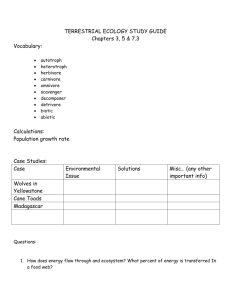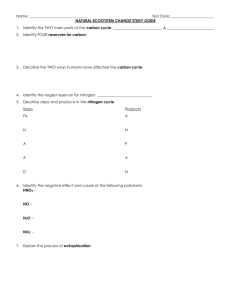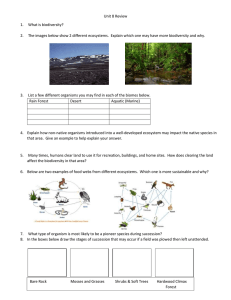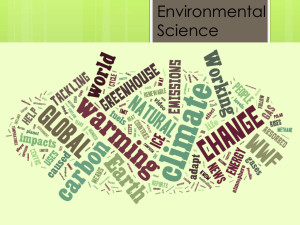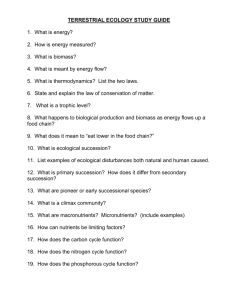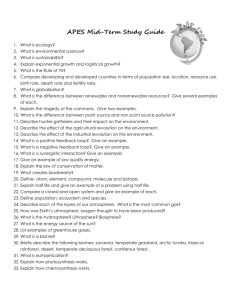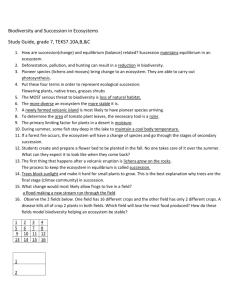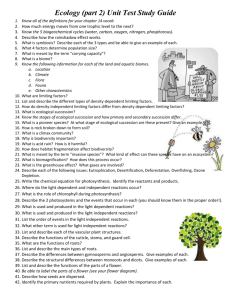High School Environmental Science Unit 3 Ecosystems 2018-2019
advertisement
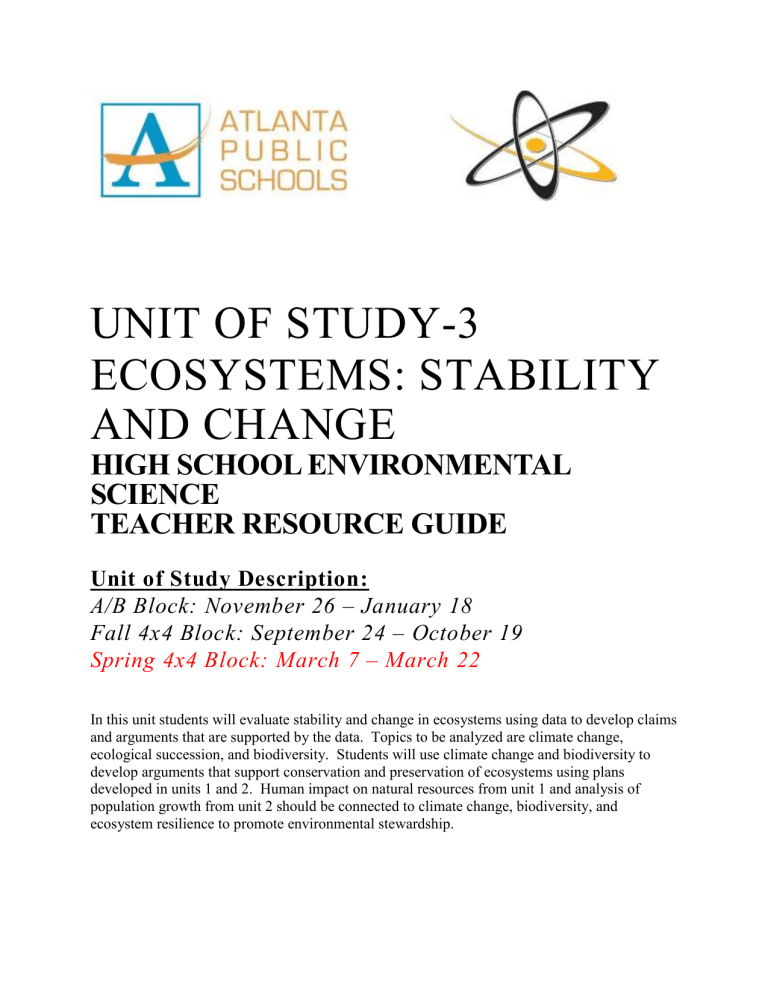
UNIT OF STUDY-3 ECOSYSTEMS: STABILITY AND CHANGE HIGH SCHOOL ENVIRONMENTAL SCIENCE TEACHER RESOURCE GUIDE Unit of Study Description: A/B Block: November 26 – January 18 Fall 4x4 Block: September 24 – October 19 Spring 4x4 Block: March 7 – March 22 In this unit students will evaluate stability and change in ecosystems using data to develop claims and arguments that are supported by the data. Topics to be analyzed are climate change, ecological succession, and biodiversity. Students will use climate change and biodiversity to develop arguments that support conservation and preservation of ecosystems using plans developed in units 1 and 2. Human impact on natural resources from unit 1 and analysis of population growth from unit 2 should be connected to climate change, biodiversity, and ecosystem resilience to promote environmental stewardship. Standards Addressed Enduring Understandings Georgia Standards of Excellence: SEV2. Obtain, evaluate, and communicate information to construct explanations of stability and change in Earth’s ecosystems. a. Analyze and interpret data related to short-term and long-term natural cyclic fluctuations associated with climate change. (Clarification statement: Short-term examples include but are not limited to El Niño and volcanism. Long-term examples include but are not limited to variations in Earth’s orbit such as Milankovitch cycles.) b. Analyze and interpret data to determine how changes in atmospheric chemistry (CO2 and methane) impact the greenhouse effect. c. Construct an argument to predict changes in biomass, biodiversity, and complexity within ecosystems, in terms of ecological succession. d. Construct an argument to support a claim about the value of biodiversity in ecosystem resilience including keystone, invasive, native, endemic, indicator, and endangered species. Short-Term cyclic fluctuations associated with climate change include El Nino, La Nina, Volcanism, Meteorite Impact, and Sunspots. These are natural occurrences. Long-Term cyclic fluctuations associated with climate change include variations in the Earth’s Orbit, Milankovitch Cycles, and Continental Drift. These are natural occurrences. Greenhouse gases impact the temperature and humidity of the Earth. These gases include carbon dioxide and methane. Ecological succession is classified as a either primary or secondary depending on the cause of the shift. The biodiversity and biomass in the early phases of succession are minimal but increase over time. The roles of species in an ecosystem dictate the resilience of the ecosystem and the biodiversity of the ecosystem. Too many or too few of these roles can lead to a catastrophic outcome for all the organisms in that ecosystem. 2 Content Integration Literacy Standards: LITERACY STANDARDS FOR READING IN SCIENCE AND TECHNICAL SUBJECTS (RST) GRADE 11-12 Key Ideas and Details: L11-12RST1 – Cite specific textual evidence to support analysis of science and technical texts. L11-12RST2 – Determine the central ideas or conclusions of a text; trace the text’s explanation or depiction of a complex process, phenomenon, or concept; provide an accurate summary of the text. Integration of Knowledge and Ideas: L11-12RST9 – Compare and contrast findings presented in a text to those from other sources (including their own experiments), noting when the findings support or contradict previous explanations or accounts. LITERACY STANDARDS FOR WRITING IN HISTORY/SOCIAL STUDIES, SCIENCE, AND TECHNICAL SUBJECTS GRADES 9-10 (WHST) Text Types and Purposes: L11-12WHST1 – Write arguments focused on discipline specific content. L11-12WHST1b – Develop claim(s) and counterclaims fairly, supplying data and evidence for each while pointing out the strengths and limitations of both claim(s) and counterclaims in a disciplineappropriate form and in a manner that anticipates the audience’s knowledge level and concerns. L11-12WHST2 – Write informative/explanatory texts, including the narration of historical events, scientific procedures/ experiments, or technical processes. Informational Text & Literary Text Resource Research to Build and Present Knowledge: L11-12WHST7 – Conduct short as well as more sustained research projects to answer a question (including a self-generated question) or solve a problem; narrow or broaden the inquiry when appropriate; synthesize multiple sources on the subject, demonstrating understanding of the subject under investigation. Primary Textbook: Holt Environmental Science: Georgia Lesson 1 (Climate Change) Chapter 13 Section 1 pgs. 351 – 358 Lesson 1 (Global Warming) Chapter 13 Section 3: pg. 363 – 369 3 Lesson 2 Chapter 5 Section 3: pgs. 137 – 141 Chapter 10 Section 1: pgs. 258 – 259 Lesson 3 Chapter 10 Sections 1 – 3: pgs. 258 – 285 Informational Texts: News Articles Links: https://www.scientificamerican.com/article/of-ants-elephants-andacacias/ Articles: LP 1.1 Short Term Climate Change Getting_to_Know__ Short_Term_Climate_Change.pdf BIRDBRAIN SCIENCE Articles (Written at 6 Different Levels) Grade: 3,4 5 6 7 8,9 10 Articles (Same article at 6 levels, see key above) Lesson Progression 1 Articles: 358_science-articleset_more-people-not-enough-minerals.pdf Lesson Progression 3 Articles: 361_science-articleset_farm-everything.pdf STEM PROJECT/ Performance Task STEM Project 4 Lesson One Progression Duration: 10 – 13 Days Focus Standard SEV2. Obtain, evaluate, and communicate information to construct explanations of stability and change in Earth’s ecosystems. a. Analyze and interpret data related to short-term and long-term natural cyclic fluctuations associated with climate change. (Clarification statement: Short-term examples include but are not limited to El Niño and volcanism. Long-term examples include but are not limited to variations in Earth’s orbit such as Milankovitch cycles.) b. Analyze and interpret data to determine how changes in atmospheric chemistry (CO2 and methane) impact the greenhouse effect. Performance-Based Objective(s) As a result of their engagement with this unit, students will know and be able to… SWBAT analyze and interpret data associated with climate change IOT compare and contrast short-term and long-term natural cyclic fluctuations. SWBAT analyze and interpret data IOT determine the relationship between changes in atmospheric chemistry and the greenhouse effect. Terms and Definitions Acid Precipitation: Precipitation, such as rain, sleet, or snow that contains a high concentration of acids, often because of the pollution of the atmosphere. Agriculture: The raising of crops and livestock for food or for other products that are useful to humans. Air Pollution: The contamination of the atmosphere by the introduction of pollutants from human and natural resources. Arable Land: Land that can be used to grow crops. Chlorofluorocarbons: Hydrocarbons in which some or all of the hydrogen atoms are replaced by chlorine and fluorine; these substances destroy the ozone layer. Climate: The average weather conditions in an area over a long period of time. Deforestation: The process of clearing forests. La Nina: The cool phase of the El NinoSouthern Oscillation; a periodic occurrence in the eastern Pacific Ocean in which the surface-water temperature becomes unusually cool. Latitude: The distance north or south from the equator; expressed in degrees. Migration: The movement of individuals between areas. Milankovitch Cycles: Cyclical movement related to the Earth's orbit around the Sun. There are three of them: eccentricity, axial tilt, and precession. Non-Point Source Pollution: Pollution that comes from many sources rather than from a single specific cite. Obliquity: The angle between the planes of the earth's equator and orbit having a value of about 23°27. (Axial Tilt) 5 Developed Countries: Countries with higher average income, slower population growth, diverse industrial economies, and stronger social support systems. Developing Countries: Countries with lower average incomes, simple and agricultural based economies, and rapid population growth. Eccentricity: Deviation of a curve or orbit from circularity. El Nino: The warm phase of the El NinoSouthern Oscillation; a periodic occurrence in the eastern Pacific Ocean in which the surface-water temperature becomes unusually warm. Emigration: Movement out of an area. Forestry: The science or practice of planting, managing, and caring for forests. Global Warming: A gradual increase in average global temperature. Greenhouse Effect: The warming of the surface and lower atmosphere of Earth that occurs when carbon dioxide, water vapor, and other gases in the air absorb and reradiate infrared radiation. Greenhouse Gases: A gas composed of molecules that absorb and radiate infrared radiation from the sun. Immigration: Movement into an area. Kyoto Protocol: The international treaty according to which developed countries that signed the treaty agree to reduce their emissions of carbon dioxide and other gases that may contribute to global warming by 2012. Ozone Hole: A thinning of stratospheric ozone that occurs over the poles during the spring. Ozone Layer: The layer of the atmosphere at an altitude of 15 to 40 km in which ozone absorbs ultraviolet solar radiation. Particulates: Fine particles that are suspended in the atmosphere and that are associated with air pollution. Point-Source Pollution: Pollution that comes from a specific site. Polar Stratospheric Clouds: A cloud that forms at altitudes of about 21,000 m during the Arctic and Antarctic winter or early spring, when air temperatures drop below -80oC. Pollution: An undesirable change in the natural environment that is caused by the introduction of substances that are harmful to living organisms or by excessive wastes, heat, noise, or radiation. Population: A group of organisms of the same species that live in a specific geographical area and interbreed. Precession: The slow movement of the axis of a spinning body around another axis due to a torque (such as gravitational influence) acting to change the direction of the first axis. It is seen in the circle slowly traced out by the pole of a spinning gyroscope. Smog: Urban air pollution composed of a mixture of smoke and fog produced from industrial pollutants and burning fuels. Temperature Inversion: The atmospheric condition in which warm air traps cooler air near Earth’s surface. Urban: Describes an area that contains a city. Urbanization: An increase in the ratio or density of people living in urban areas rather than in rural areas. Volcanism: Volcano activity or phenomena. 6 Guiding Questions: 1. Why does El Nino occur randomly? 2. What are some of the negative impacts of El Nino? 3. What is the major difference between long-term and short-term cyclic fluctuations? 4. Why is it important to analyze data when evaluating these fluctuations? 5. What is the relationship between carbon dioxide and temperature change? 6. How does the amount of energy in each level of the atmosphere impact the greenhouse effect? 7. How does the population effect the amount of carbon in the atmosphere and the greenhouse effect? 8. What can be done to reduce the greenhouse effect? Interpretation and Reminders: Climate is the average weather conditions in an area over a long period of time. A good example is a tropical climate which is characterized as hot with a great deal of precipitation. Climate is NOT weather. Weather is a snapshot and may deviate from the climate in extreme situations. This must be understood to really analyze climate change and the natural causes of climate change. Short-term natural cyclic fluctuations associated with climate change include El Nino, volcanic eruptions (volcanism), meteorite impacts, and sunspots. 7 Long-term cyclic fluctuations that are related to climate change include continental drift, Earth’s orbit, and Milankovitch Cycles. Per the standard students should analyze data related to long term cyclic fluctuations and relate this data to continental drift and Milankovitch Cycles. Memorizing the processes is not as important as having students relate data sets to continental drift, Earth’s orbit, and Milankovitch Cycles. 8 Greenhouse gases trap heat in the Earth’s atmosphere. There are several greenhouse gases which include water vapor, methane, carbon dioxide, nitrogen trifluoride, sulfur hexafluoride, hexafluoroethane, and nitrous oxide. These lesson should focus on methane and carbon dioxide. This unit focuses on the effect of population growth on the amount of greenhouse gas emissions as well as the impact of human activity on climate change. 9 Order of Teaching 1. Analyze climate and climate change 2. Compare and contrast long-term and short-term cyclic fluctuations related to climate change. 3. The greenhouse effect, atmospheric chemistry, and human impact (i.e. population, activity). Claim-Evidence-Reasoning (CER) Claim: Statement that answers the question. Evidence: Information that supports the claim. Scientific data comes from observations in natural settings or controlled experiments, measurements, or valid scientific sources. Personal information comes from opinions, beliefs, and everyday experiences. Reasoning: The justification that links the evidence to the claim. It explains why the evidence supports the claim. Scientific reasoning includes a scientific principle. It is not enough for students to answer the focus question of a lab. Students must provide evidence for their claim and then develop an argument. The argument in turn becomes the reasoning that ties the evidence and claim to a scientific phenomenon. In some instances the activities will come be Argument Driven Inquiry, which builds on the foundation of CER. CER Framework CER Framework.docx Greek and Latin Root Words Deforestation: De = away from, down tion = action of To increase literacy in the classroom, students will practice identifying, defining, and utilizing Greek and Latin Root Words in Scientific Vocabulary on a daily/week basis. The purpose of these exercises it to enhance student understanding of science-based terms, as well everyday vocabulary. A section of their notebook should be allocated specifically for vocabulary. Suggested: Students should practice writing down the prefix as well as the definition. Following each prefix/suffix, ensure that examples are given so that students can connect the prefix/suffix to its definition. Scientific Prefixes and Suffixes.pdf Misconceptions/Proper Conceptions Misconceptions: All climate change and greenhouse gas production is caused by human activity. Proper Conceptions: There are some causes of climate change that are related to natural cyclic fluctuations. Greenhouse gases can be produced independent of human activity. 10 Suggested Learning Experiences Core Ideas: Science & Engineering Practices: Crosscutting Concepts: Climate Change Analyzing and Interpreting Data Cause and Effect Stability and Change Annotate the Objective Break into smaller components for the purpose of study or examination. SWBAT analyze and interpret data associated with climate change IOT compare and contrast short-term and long-term natural cyclic fluctuations. To exhibit unlikeness on comparison with something else. General Academic Vocabulary Analyze Compare Contrast Domain Specific Vocabulary Climate Change Cyclic Fluctuations Phenomenon: El Nino Crosscutting Concepts Graphic Organizers Cause and Effect Stability and Change Cause and Effect GO.pdf Stability and Change GO.pdf Engage: This lesson will last more than one day. In the case that you would like to have an engage for each day please use the videos on page. (Use appropriate video to review or give students a preview of what they are about to learn). Note for Evaluator: If you observe the teacher in the first 5-10 minutes of class and they have already done the Engage below, the teacher may use a different engage (i.e. hook). Students will observe the demonstration here: http://www.formontana.net/eldemo.html or https://sealevel.jpl.nasa.gov/files/archive/make-your-own-el-nino.html Guiding Questions: 1. What happens to the red food coloring in the hot water? 2. How is this related to climate change? Teacher Notes/Discourse: This demo is a copy of the El Nino phenomenon. 11 GUIDED INSTRUCTION Explore: Description of the Activity: Students will complete the activity about El Nino. Students will keep a graphic organizer for each short-term and long-term cyclic fluctuation associated with climate change. Handout Answer Key ninsall.pdf ninkey.pdf Teacher Notes/Discourse: Students need to identify El Nino as a short-term change. L11-12RST1-2: Students will annotate and summarize the introduction portion of the student handout before completing the investigation. Guiding Questions: 1. What did the color code on the map represent? 2. Why does El Nino occur randomly? 3. What are some of the negative impacts of El Nino? FOCUS LESSON Explain: Students will use the Power Point to organize short-term and long-term natural cyclic fluctuations related to climate change. Power Point (Slides 1-11) ch_14.3-4_climate_c hange.pptx Teacher Notes/Discourse: It is important for students take the information that they collected and organize the content as short-term or long-term. Guiding Questions: 1. What is the major difference between long-term and short-term cyclic fluctuations? 2. Why is it important to analyze data when evaluating these fluctuations? 12 COLLABORATIVE PRACTICE Elaborate: Students will complete an activity on the Milankovitch Cycles. Lesson Plan with Student Handouts MilankovitchLesson Plan.pdf Teacher Notes: Students need to identify Milankovitch Cycles as a long-term change. INDEPENDENT PRACTICE Evaluate: Students will construct a graphic organizer that identifies each of the cyclic fluctuations which should include short-term/long-term, characteristics, key vocabulary (e.g. and location (if applicable). Students will use their previous investigations, notes and informational text. L11-12RST9: Students will compare the notes, informational text, and the data that they analyzed to support the information in the graphic organizer. L11-12 WHST1: Write arguments focused on discipline-specific content. b. Support claim(s) with logical reasoning and relevant, accurate data and evidence that demonstrate an understanding of the topic or text, using credible sources. Teacher Notes: Make sure that students have a running list of short-term and long-term cyclic fluctuations associated with climate change. The Explore portion of the lesson introduced a prevalent short-term fluctuation and the Elaborate portion of the lesson introduced a prevalent long-term fluctuation. Students will need to fill in others using the Explain portion of the lesson. 13 Multiple Choice Formative Assessment (5 Questions) SEV2.a LP1.1 Quiz.pdf Collect student data on this short quiz. Have students fill their data based on Quiz 1: Short-term and Long-term Cyclic Fluctuations. As students move through each section please either provide them with remediation and enrichment as well as an opportunity to reflect on their learning. The following attachment provides a table for keeping data, sections for enrichment and remediation by standard, and a place for students to reflect on what they know. Student Data Tracking Sheet Unit 3 Environmental Science Student Data Tracking Sheet.pdf Annotate the Objective: Break into smaller components for the purpose of study or examination SWBAT analyze and interpret data IOT determine the relationship between changes in atmospheric chemistry and the greenhouse effect. General Academic Vocabulary Analyze Interpret Domain Specific Vocabulary Atmospheric Chemistry Greenhouse Effect Phenomenon: Greenhouse Effect Crosscutting Concepts Graphic Organizers Cause and Effect Stability and Change Cause and Effect GO.pdf Stability and Change GO.pdf Engage: This lesson will last more than one day. In the case that you would like to have an engage for each day please use the videos on page 14. (Use appropriate video to review or give students a preview of what they are about to learn). Note for Evaluator: If you observe the teacher in the first 5-10 minutes of class and they have already done the Engage below, the teacher may use a different engage (i.e. hook). 14 Students will watch the video: https://youtu.be/kwtt51gvaJQ or you can actually set up the demonstration using the handout below. Demonstration Handout HowTo_Greenhous eEffect.pdf Post the following questions: 1. What is the relationship between carbon dioxide and temperature change? 2. How does this demonstration model the greenhouse effect? GUIDED INSTRUCTION Explore: Students will complete the use a model to demonstrate the greenhouse effect as it relates to atmospheric chemistry. Lesson Plan with Student Handout WhatIsAModel.pdf Teacher Notes/Discourse: Students will use chips and a handout to model the greenhouse effect. This lesson progression is intended for students to make connections to human impact (greenhouse gas production) on the greenhouse effect. Guiding Questions: 1. How does the amount of energy in each level of the atmosphere impact the greenhouse effect? 2. What do the chips represent? 15 FOCUS LESSON Explain: Students will use the Power Point and Notes Outline Power Point (Slides 12-27) ch_14.3-4_climate_c hange.pptx Teacher Notes/Discourse: These notes are a continuation of the first lesson progression and help students understand that there are multiple reasons for climate change. Some are caused by living things and others are not related to living things. Guiding Questions: 1. How does the population effect the amount of carbon in the atmosphere and the greenhouse effect? 2. What can be done to reduce the greenhouse effect? COLLABORATIVE PRACTICE Elaborate: Students will complete the activity that helps them understand their individual impact on the production of greenhouse gases. Lesson Plan Specifics for the Teacher: https://scied.ucar.edu/activity/plugged-co2 Student Handouts and Poster: plugged1.pdf plugged2-1.pdf Fuel_types_plugge d.pdf Teacher Notes: This lesson will help students use their own data and provides them with an opportunity to reflect on their decision making in the context of the greenhouse effect. 16 INDEPENDENT PRACTICE Evaluate: Students will present their findings from the Elaborate portion of the lesson and come up with ways to reduce the amount of greenhouse gases they are responsible for producing. Students will also complete the Global Warming Venn Diagram. Global Warming Venn globalvenn.pdf Writing Standard: L11-12WHST1: Write arguments focused on discipline-specific content. b. Support claim(s) with logical reasoning and relevant, accurate data and evidence that demonstrate an understanding of the topic or text, using credible sources Multiple Choice Formative Assessment (5 Questions) SEV2.b LP1.2 Quiz.pdf • • Collect student data on this short quiz. Have students fill their data based on Quiz 2: Greenhouse Effect. As students move through each section please either provide them with remediation and enrichment as well as an opportunity to reflect on their learning. The following attachment provides a table for keeping data, sections for enrichment and remediation by standard, and a place for students to reflect on what they know. Student Data Tracking Sheet Unit 3 Environmental Science Student Data Tracking Sheet.pdf Additional Resources: ONLINE http://eeingeorgia.org/net/content/search.aspx?s=0.0.68.4863&btid=8 (EEA Georgia) https://www.epa.gov/students/lesson-plans-teacher-guides-and-online-resourceseducators (EPA Educator Resources) http://www.bbc.com https://enviroliteracy.org/ https://www.climate.gov/climate-and-energy-topics/causes-climate-change https://scied.ucar.edu/shortcontent/how-volcanoes-influence-climate (Volcanism) https://oceanservice.noaa.gov/facts/ninonina.html (El Nino and La Nina) 17 Videos: https://youtu.be/WPA-KpldDVc (El Nino and La Nina) https://youtu.be/d6s0T0m3F8s (El Nino and Climate Change) https://youtu.be/RleDV5tzIZo (Volcanism) https://youtu.be/F_MuTEJfFzo (Sunspots and Climate Change) https://youtu.be/hphdsLcSTYQ (Causes of Global Warming) https://youtu.be/PFfwIOzVlh8 (Milankovitch Cycles) https://youtu.be/ZD8THEz18gc (Khan Academy: Milankovitch Cycles) https://youtu.be/ZzCA60WnoMk (NASA: Greenhouse Effect) https://youtu.be/ryg3zu4e3y4 (Greenhouse Gases) Lessons: Global Warming Power Point and Note-Taking Sheet Climate Change.pptx Climate Change Notes Outline (1).docx Global Warming and Hurricane Data Analysis Global Warming and Hurricanes Data Analysis Activity.docx Article Analysis: Climate Refugees (Article and Questions) Climate Refugees.pdf Movies: An Inconvenient Truth Inconvenient Truth.docx Differentiated Supports Learning Difficulty Reading Assignment - Climate Refugees.docx Frozen Planet: On Thin Ice Frozen Planet - On Thin Ice.docx The Island President The Island President - Video Worksheet.docx • Small group, flexible grouping, pull outs, one-on-one, tiered assignments, varied assessments. The following handouts are scaffolded from basic understanding to more complex in nature: Students that Struggle with: Topic 1: Volcanism Volcanism_Worksh eet.pdf 18 Topic 2: Climate Change Study Guide Climate Change Study Guide.docx High Achieving • Students will engage in higher-level discussions, exit ticket journaling, peer collaboration, and will revise/edit their written work based on peer and teacher feedback. Topic 1: Global Warming Research Essay Global Warming Essay.docx English Learners Language Standard: • WIDA ELD Standard 1: English language learners communicate for Social and Instructional purposes within the school setting. WIDA ELD Standard 4: English language learners communicate information, ideas and concepts necessary for academic success in the content area of Science. • Provide differentiated support and scaffolding based on the English Language Proficiency Level of the English Learner using the WIDA Can Do Descriptors. http://tinyurl.com/apsesol Resources TEXTBOOK ACTIVITIES: Climate Change, Fluctuations, and the Greenhouse Effect Chapter 13 Sections 1, 3 Fold Notes pg. 350 Quick Lab: Investigating Prevailing Winds pg. 354 Case Study: Ice Cores: Reconstructing Past Climates pgs. 354 – 355 Math Practice: Precipitation Extremes on Earth pg. 358 Field Activity: Carbon Dioxide pg. 364 Inquiry Lab: Modeling pgs. 376 – 377 Making a Difference: Ozone Scientist pgs. 378 – 379 ONLINE RESOURCES: Emory Cases Online http://www.cse.emory.edu/cases/ CK-12 Foundation http://www.ck12.org/teacher/ NSTA Outstanding Science Trade Books for Students K-12 http://www.nsta.org/publications/ostb/ Khan Academy https://www.khanacademy.org/ Study Tool K-12 http://quizlet.com/math-and-science/ Problem-Attic Test Prep Question Generator http://www.problem-attic.com/ Common Core Personalized Learning https://www.opened.io/ Georgia Public Broadcasting http://www.gpb.org Environmental Protection Agency: https://www.epa.gov Environmental Education in Georgia: http://eeingeorgia.org 19 Lesson Two Progression Duration: 5 – 7 Days Focus Standard SEV2. Obtain, evaluate, and communicate information to construct explanations of stability and change in Earth’s ecosystems. c. Construct an argument to predict changes in biomass, biodiversity, and complexity within ecosystems, in terms of ecological succession. Performance-Based Objective(s) As a result of their engagement with this unit, students will know and be able to… SWBAT evaluate ecological succession IOT construct an argument to predict changes in biomass, biodiversity, and complexity within ecosystems. Terms and Definitions Biodiversity: The variety of organisms in a given area, the genetic variation within a population, the variety of species within a community, or the variety of communities in an ecosystem. Biomass: The total mass of organisms in a given area or volume. Climax Community: The final, stable community in equilibrium with the environment. Ecological Succession: A gradual process of change and replacement in a community. Pioneer Species: A species that colonizes an uninhabited area and that starts an ecological cycle in which many other species become established. Primary Succession: The succession that begins in an area that previously did not support life. Secondary Succession: The process by which one community replaces another community that has been partially or totally destroyed. Ecosystem: A community of organisms and their abiotic environment. Guiding Questions: 1. Why does it take so much time for the biodiversity to increase? 2. How are biodiversity and biomass related in the context of succession? 3. What is the main difference between primary and secondary succession? 4. How can ecological succession be a good thing? 20 Interpretation and Reminders: There are two types of ecological succession; Primary and Secondary Succession. Primary succession occurs in an area that did not previously support life. Secondary succession occurs in an area that has had some sort of catastrophe. 21 In the early phases of ecological succession the ecosystem lacks a great deal of biodiversity, biomass, and complexity. Order of Teaching 1. Describe Ecological Succession 2. The effect of succession on biomass, biodiversity, and complexity of the ecosystem. 3. Predictions about succession in regards to the effect on ecosystem. Greek and Latin Root Words To increase literacy in the classroom, students will practice identifying, defining, and utilizing Greek and Latin Root Words in Scientific Vocabulary on a daily/week basis. The purpose of these exercises it to enhance student understanding of science-based terms, as well everyday vocabulary. A section of their notebook should be allocated specifically for vocabulary. Suggested: Students should practice writing down the prefix as well as the definition. Following each prefix/suffix, ensure that examples are given so that students can connect the prefix/suffix to its definition. Scientific Prefixes and Suffixes.pdf Misconceptions/Proper Conceptions Misconceptions: Ecological succession is unidirectional and linear process. Proper Conceptions: Ecological succession is cyclical in nature and may initiate in different ways (e.g. Lichens are not always the first species) 22 Suggested Learning Experiences Core Ideas: Science & Engineering Practices: Natural Resources Constructing Arguments from Evidence Crosscutting Concepts: Patterns Cause and Effect Stability and Change Annotate the Objective: Form an idea of the amount, number, or value of Get, acquire, or secure something. SWBAT evaluate ecological succession IOT construct an argument to predict changes in biomass, biodiversity, and complexity within ecosystems. The action or process of reasoning systematically in support of an idea, action, or theory General Academic Vocabulary Evaluate Argument Predict Domain Specific Vocabulary Ecological Succession Biomass Biodiversity Ecosystems Phenomenon: A natural disaster can cause the new ecosystem to completely change. Crosscutting Concepts Graphic Organizers Cause and Effect Patterns Cause and Effect GO.pdf Patterns GO.pdf Engage: This lesson will last more than one day. In the case that you would like to have an engage for each day please use the videos on page. (Use appropriate video to review or give students a preview of what they are about to learn). Note for Evaluator: If you observe the teacher in the first 5-10 minutes of class and they have already done the Engage below, the teacher may use a different engage (i.e. hook). 23 Students will watch the video: https://youtu.be/9kkWxUgMHfA Guiding Questions: 1. How does ecological succession start? GUIDED INSTRUCTION Explore: Students will use a simulation to analyze primary and secondary succession Handout unit 5 ecology virtual lab ecological succession.docx Teacher Notes/Discourse: • Students should state a claim supported by evidence to relate each succession to increased complexity and biodiversity in an ecosystem. Guiding Questions: 1. Why does it take so much time for the biodiversity to increase? 2. How are biodiversity and biomass related in the context of succession? FOCUS LESSON Explain: Students will use the Power Point and Notes Guide. Power Point ECOLOGICAL SUCCESSION1.ppt Teacher Notes/Discourse: Students should relate ecological succession to biodiversity and complexity of ecosystems otherwise we are just re-teaching a biology concept. They will use this information in the last unit. Guiding Questions: 1. What is the main difference between primary and secondary succession? 2. How can ecological succession be a good thing? 24 COLLABORATIVE PRACTICE Elaborate: Students will complete a forest succession activity to analyze the change in biodiversity over time. Student Handout forest+succession+ activity-1.doc Teacher Notes: The graphs and data should be used as evidence to support the claim that the biodiversity, biomass, and complexity of an ecosystem increase over time. INDEPENDENT PRACTICE Evaluate: Students will complete the question Question and Rubric Sample Open Ended Question with Key.pdf Teacher Notes: This open ended question is from the AP Biology exam; however, the question is perfectly aligned to the standard. Modify as needed. Make sure that students provide a comprehensive explanation using the CER Framework. Writing Standard: L11-12WHST1: Write arguments focused on discipline-specific content. b. Support claim(s) with logical reasoning and relevant, accurate data and evidence that demonstrate an understanding of the topic or text, using credible sources Multiple Choice Formative Assessment (5 Questions) SEV2.c LP2.1 Quiz.pdf Collect student data on this short quiz. Have students fill their data based on Quiz 3: Ecological Succession As students move through each section please either provide them with remediation and enrichment as well as an opportunity to reflect on their learning. The following attachment provides a table for keeping data, sections for enrichment and remediation by standard, and a place for students to reflect on what they know. Student Data Tracking Sheet Unit 3 Environmental Science Student Data Tracking Sheet.pdf 25 Additional Resources: ONLINE https://www.eh-resources.org/ http://environmentalhistory.org/ https://ed.ted.com/lessons?category=environmental-science http://www.pbs.org Videos: https://youtu.be/V49IovRSJDs (Bozeman Science: Ecological Succession) https://youtu.be/d7xbyNSxxrI (Khan Academy: Ecological Succession) Differentiated Supports Learning Difficulty • Small group, flexible grouping, pull outs, one-on-one, tiered assignments, varied assessments. The following handouts are scaffolded from basic understanding to more complex in nature: Students that Struggle with: Topic 1: Ecological Succession Ecological Succession Lab.pdf High Achieving • Students will engage in higher-level discussions, exit ticket journaling, peer collaboration, and will revise/edit their written work based on peer and teacher feedback. These activities are to give students more practice but they are more complex: English Learners Language Standard: • WIDA ELD Standard 1: English language learners communicate for Social and Instructional purposes within the school setting. WIDA ELD Standard 4: English language learners communicate information, ideas and concepts necessary for academic success in the content area of Science. • Provide differentiated support and scaffolding based on the English Language Proficiency Level of the English Learner using the WIDA Can Do Descriptors. http://tinyurl.com/apsesol 26 Resources TEXTBOOK ACTIVITIES: Chapter 5 Section 3 Graphic Organizer: Chain-of-Events Chart pg. 137 Case Study: Communities Maintained by Fire pgs. 138 – 139 Field Activity: Investigating Succession pg. 140 ONLINE RESOURCES: Emory Cases Online http://www.cse.emory.edu/cases/ CK-12 Foundation http://www.ck12.org/teacher/ NSTA Outstanding Science Trade Books for Students K-12 http://www.nsta.org/publications/ostb/ Khan Academy https://www.khanacademy.org/ Study Tool K-12 http://quizlet.com/math-and-science/ Problem-Attic Test Prep Question Generator http://www.problem-attic.com/ Common Core Personalized Learning https://www.opened.io/ The Physics Classroom http://www.physicsclassroom.com/ Georgia Public Broadcasting http://www.gpb.org/physics-fundamentals/episodes/physics/all 27 Lesson Progression Three 7 – 10 Days Focus Standard SEV2. Obtain, evaluate, and communicate information to construct explanations of stability and change in Earth’s ecosystems. d. Construct an argument to support a claim about the value of biodiversity in ecosystem resilience including keystone, invasive, native, endemic, indicator, and endangered species. Performance-Based Objective(s) As a result of their engagement with this unit, students will know and be able to… SWBAT identify and analyze keystone, invasive, native, endemic, indicator, and endangered species IOT construct an argument to support a claim about the value of biodiversity in ecosystem resilience. Terms and Definitions Biodiversity: The variety of organisms in a given area, the genetic variation within a population, the variety of species within a community, or the variety of communities in an ecosystem. Indicator Species: An organism whose presence, absence or abundance reflects a specific environmental condition. Keystone Species: A species that is critical to the functioning of the ecosystem in which it Endangered Species: A species that has been lives because it affects the survival and identified to be in danger of extinction abundance of many other species in its throughout all or part of its range, and that is community. thus under the protection by regulations or Native Species: A species that normally lives conservation measures. and thrives in a particular ecosystem. Endemic Species: A species that is native to a particular place and this found only there. Exotic Species: A species that is not native to a particular region. Threatened Species: A species that has been identified to be likely to become endangered in the foreseeable future. Germ plasm: Hereditary material contained in protoplasm. Guiding Questions: 1. How does the number of beans represent the different types of species? 2. How could you model an invasive species using the beans? 3. How is genetic variation related to biodiversity? 4. How do each do each of the species’ roles impact the biodiversity of an ecosystem? 28 Interpretation and Reminders: Biodiversity is impacted by the numbers and roles of species in an ecosystem. Order of Teaching 1. Biodiversity in General 2. Each type of species in an ecosystem (i.e. keystone, invasive, native, endemic, indicator, and endangered) 3. The relationship between each of these species and biodiversity. Greek and Latin Root Words To increase literacy in the classroom, students will practice identifying, defining, and utilizing Greek and Latin Root Words in Scientific Vocabulary on a daily/week basis. The purpose of these exercises it to enhance student understanding of science-based terms, as well everyday vocabulary. A section of their notebook should be allocated specifically for vocabulary. Suggested: Students should practice writing down the prefix as well as the definition. Following each prefix/suffix, ensure that examples are given so that students can connect the prefix/suffix to its definition. Scientific Prefixes and Suffixes.pdf 29 Misconceptions/Proper Conceptions Misconceptions: Invasive species help balance ecosystems. Proper Conceptions: Invasive species can cause an imbalance in an ecosystem. Suggested Learning Experiences Core Ideas: Science & Engineering Practices: Natural Resources Engaging in an Argument from Evidence Annotate the Objective: Crosscutting Concepts: Cause and Effect Stability and Change Break into smaller components for the purpose of study or examination SWBAT identify and analyze keystone, invasive, native, endemic, indicator, and endangered species IOT construct an argument to support a claim about the value of biodiversity in ecosystem resilience. General Academic Vocabulary Analyze Argument Claim Domain Specific Vocabulary Keystone Species Invasive Species Native Species Endemic Species Indicator Species Endangered Species Biodiversity Ecosystem Resilience Phenomenon: The African elephant knocks down Acacia Trees which would normally overrun the ecosystem and inhibit plant biodiversity. Crosscutting Concepts Graphic Organizers Cause and Effect Patterns Cause and Effect GO.pdf Patterns GO.pdf Engage: This lesson will last more than one day. In the case that you would like to have an engage for each day please use the videos on page. (Use appropriate video to review or give students a preview of what they are about to learn). Note for Evaluator: If you observe the teacher in the first 5-10 minutes of class and they have already done the Engage below, the teacher may use a different engage (i.e. hook). 30 Students will watch the video: https://youtu.be/_fOTH59Z0ZA Guiding Questions: 1. Why does the elephant’s destruction of the trees promote plant biodiversity? GUIDED INSTRUCTION Explore: Students will complete a biodiversity lab Handout biodiversitybeanlab _revised.doc Teacher Notes/Discourse: This will help students frame their thinking around the impact they have on their environment. Guiding Questions: 1. How does the number of beans represent the different types of species? 2. How could you model an invasive species using the beans? FOCUS LESSON Explain: Students will use the Power Point and note-taking guide. Power Point Note-taking Guide ch10_sec1_revised.p pt chapter_10_-_biodiv ersity_lecture_guide.docx Guiding Questions: 1. How is genetic variation related to biodiversity? 2. How do each do each of the species’ roles impact the biodiversity of an ecosystem? Teacher Notes/Discourse: These notes follow the textbook and require a great deal of inference and discussion to make connections to the performance based objective. 31 COLLABORATIVE PRACTICE Elaborate: Students will create a presentation that highlights each of the following: Keystone, Invasive, Native, Endemic, Indicator, and Endangered Species. Guiding Question for Each Species: How does this species impact biodiversity for the ecosystem that it occupies? (Done for each species and incorporated into the presentation) Sample Presentation endangered-specie s-project-jennifer.ppt Teacher Notes: Students will construct a presentation to address each of the species represented in the standard (i.e. endangered, invasive, etc.) INDEPENDENT PRACTICE Evaluate: Student will use their presentations to construct a matrix of all the species that they observed in their peers presentations. Teacher Notes: Students will use their matrix to write a concluding statement in the CER format. Writing Standard: L11-12WHST1: Write arguments focused on discipline-specific content. b. Support claim(s) with logical reasoning and relevant, accurate data and evidence that demonstrate an understanding of the topic or text, using credible sources Multiple Choice Formative Assessment (5 Questions) SEV2.d LP3.1 Quiz.pdf • • Collect student data on this short quiz. Have students fill their data based on Quiz 4: Biodiversity As students move through each section please either provide them with remediation and enrichment as well as an opportunity to reflect on their learning. The following attachment provides a table for keeping data, sections for enrichment and remediation by standard, and a place for students to reflect on what they know. Student Data Tracking Sheet Unit 3 Environmental Science Student Data Tracking Sheet.pdf 32 Additional Resources: ONLINE • http://www.conservation.org/how/pages/hotspots.aspx • http://www.americanornithology.org/content/biodiversity-data-resources • http://animaldiversity.org/ • https://www.nationalgeographic.org/encyclopedia/biodiversity/ Videos: • hhttps://youtu.be/E7IK_qt0hEw (Endemic Species) • https://youtu.be/JGcIp4YEKrc (Keystone Species) • https://youtu.be/xRfdDE6scWA (Keystone vs. Indicator Species) • https://youtu.be/spTWwqVP_2s (Invasive Species) • https://youtu.be/yqLkSHlf5DE (Invasive Species) • https://youtu.be/FsX71DHVO8k (Endangered Species) • https://youtu.be/jFBCBmK9E3U (Bozeman Science: Ecological Resilience) Lessons: Study Guide chapter_10_study_g uide.docx Invasive Species Georgia invasive georgia.pdf Movies: The Blue Planet: Seasonal Seas blue_planet_-_seas onal_seas_video_questions.pdf Differentiated Supports Learning Difficulty Medicine Man the_medicine_man_ video_questions_cp.doc • Small group, flexible grouping, pull outs, one-on-one, tiered assignments, varied assessments. The following handouts are scaffolded from basic understanding to more complex in nature: Students that Struggle with: Topic 1: Biodiversity Webquest biodiversity_hotspo ts_webquest.docx 33 High Achieving • Students will engage in higher-level discussions, exit ticket journaling, peer collaboration, and will revise/edit their written work based on peer and teacher feedback. These activities are to give students more practice but they are more complex: Topic 1: Invasive Species Project least_wanted_proje ct_poster.doc English Learners Language Standard: • WIDA ELD Standard 1: English language learners communicate for Social and Instructional purposes within the school setting. WIDA ELD Standard 4: English language learners communicate information, ideas and concepts necessary for academic success in the content area of Science. • Provide differentiated support and scaffolding based on the English Language Proficiency Level of the English Learner using the WIDA Can Do Descriptors. http://tinyurl.com/apsesol Resources TEXTBOOK ACTIVITIES: Chapter 10 Sections 1-3 Fold Notes: Four Corner Fold pg. 258 Case Study: A Genetic Gold Rush in the Rain Forests pgs. 266 – 267 Graphic Organizer: Spider Map pg. 271 Quick Lab: Design a Wildlife Preserve pg. 272 Math Practice: Measuring Risk pg. 274 Field Activity: Simple Biodiversity Assessment pg. 275 Exploration Lab: Differences in Diversity pgs. 282 – 283 Making A Difference pgs. 284 - 285 ONLINE RESOURCES: Emory Cases Online http://www.cse.emory.edu/cases/ CK-12 Foundation http://www.ck12.org/teacher/ NSTA Outstanding Science Trade Books for Students K-12 http://www.nsta.org/publications/ostb/ Khan Academy https://www.khanacademy.org/ Study Tool K-12 http://quizlet.com/math-and-science/ Problem-Attic Test Prep Question Generator http://www.problem-attic.com/ Common Core Personalized Learning https://www.opened.io/ The Physics Classroom http://www.physicsclassroom.com/ Georgia Public Broadcasting http://www.gpb.org/physics-fundamentals/episodes/physics/all 34 Assessments Formative Assessments: Utilize data from assessments to help drive instructional practices. 2-5 Question Selected Response Formatives Unit 1 Student Data Tracker Summative: Summative assessments should be administered at the end of each unit based on objectives taught from the current unit. Assessments can be created online, printed and distributed Unit 3 Environmental Science Student Data Tracking Sheet.pdf to students via: Lesson Progression 1 Quizzes AAAS Science Assessment http://assessment.aaas.org/ Problem-Attic: http://www.problem-attic.com/ Quiz 1 SEV2.a LP1.1 Quiz.pdf Quiz 2 SEV2.b LP1.2 Quiz.pdf Lesson Progression 2 Quiz Quiz 3 SEV2.c LP2.1 Quiz.pdf Lesson Progression 3 Quiz Quiz 4 SEV2.d LP3.1 Quiz.pdf 35 Kahoot, Jeopardy, Trivia bowl. 3.2.1.Reflection.doc x Look Back.docx Odd One Out.Template.docx Scientist Idea Group Talk Comparison Template.docx Feedback Template.docx Frayer Model Template.doc Example NonExample Template.docx Feedback to Feed Evaluation of Forward Template.docx Learning Gains.Template.docx Always_Sometimes_ Card Sort Never_Template_1.docx Template.docx Performance Tasks Name of Task: Description: Standard: Cognitive Rigor: DOK Glossary of Teaching Strategies Lab notebook or Field sketchbook: A notebook that students use to record data, journal on assigned topics and complete assigned drawing activities. Ticket Out the Door/Exit Ticket: A commonly used summarizing strategy that is effective as a formative assessment tool. Students are given a short writing assignment on the concept covered in class that is to be turned in as they leave the classroom. These brief glimpses into student understanding may be graded or not. The same strategy can be used as a Ticket In the Door to assess student understanding at the beginning of the class on a concept from the day before or as a check on a homework assignment. KIM diagrams: A three column table where students can organize technical language to allow better understanding of how they relate to the topic of the day. On a KIM diagram, a key term is listed in the first column, an illustration of the key term in the second column and a student derived meaning written in the third column. Jigsaw Activities: An effective grouping strategy that teachers use to facilitate peer teaching in the classroom. Students are first grouped together to become experts on an assigned topic. Student groups are then reorganized in such a manner that new groups are formed containing one student from each of the expert groups. The experts on each topic then serve as a peer teacher to the other students in the newly formed group. Cloze: A note taking strategy where students either provide missing terms to complete a paragraph using appropriate language for the topic being addressed, or where students generate a paragraph from a list of appropriate terms. 36 Gallery or Poster Walk: This is a peer assessment strategy. Students place their work on a wall or other location where it can be reviewed by their peers. Students provide written commentary on the posted work and the original creators are given the opportunity to revise their product. Teacher note: Students may require training to use appropriate feedback in their commentary. Flapbook or Flipbook: A type of graphic organizer where students group information in order to see relationships within categories. 10-2 Lecture format: A strategy where teachers limit the introduction of material to a time frame of 10 minutes or less and then students are allowed a 2 minute opportunity to reflect on the material and share what they have learned with their peers. Glaze the Doughnut: A type of organizer that allows teachers to pre-assess student knowledge or to monitor student progress that resembles a doughnut as one smaller circle is drawn inside another. The big idea is written inside the small circle and the doughnut is “iced” or “glazed” with what the students know about the topic. The information can then be reorganized into tables or organizers. Name Jar: A strategy to ensure students are randomly selected to answer questions in class. Student names are placed on craft sticks and placed in a jar. During questioning the teacher selects sticks from the jar and the student identified must answer the question. Several blank sticks could be included in which the teacher must answer the questions when they are selected. KWL: A pre and post assessment strategy often used in classrooms where, at the beginning of the lesson, teachers guide students to identify what they already know about a particular topic and what they need to know about the topic. Following the lesson, the teacher leads students to review what they have learned. Acrostic: An activity for students to make connections between language that often accompanies a particular topic. The key term is written vertically on paper and students write words or phrases that relate to that term using the letters that make up the key term. References GeorgiaStandards.org. Retrieved from https://www.georgiastandards.org/frameworks/science Edgenuity https://mybackpack.apsk12.org/Pages/myBackpack.aspx 37
